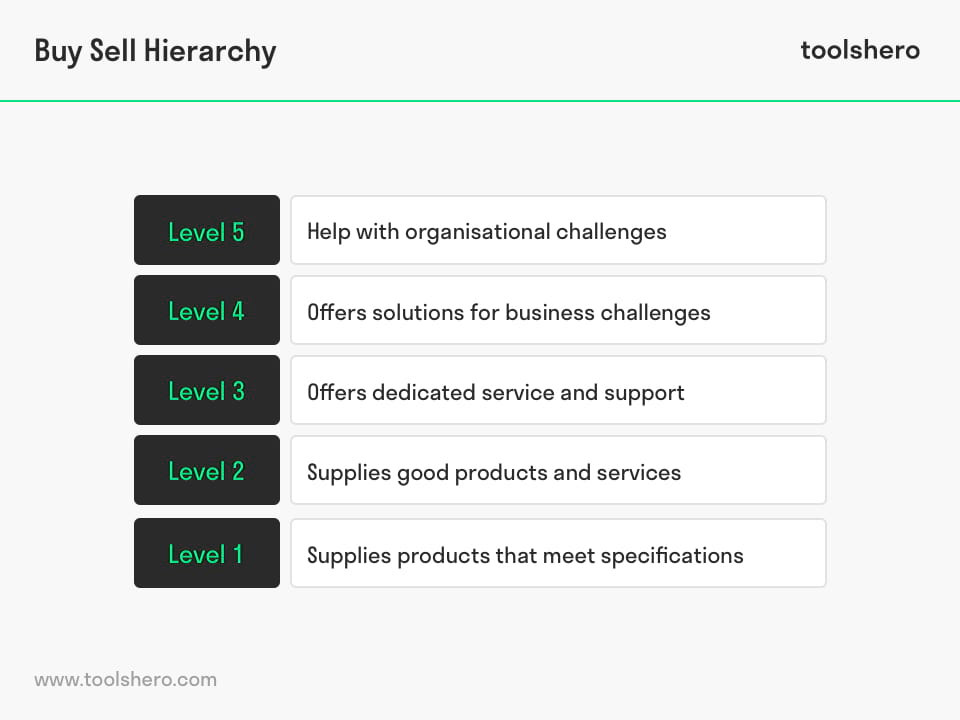Buy Sell Hierarchy (Miller and Heiman)

This article provides a practical explanation of the Buy Sell Hierarchy method. After reading, you’ll have a better understanding about how you can judge your current situation and where you want it to be in the next three years. The most important goal of this marketing method is offering reliable benchmarks. Not just to measure how you look at customers, but also how customers view you and your company.
What is the Buy Sell Hierarchy?
This method helps you to explore existing relations with customers. More specifically, it helps you think about how closely you are working together with them.
Two consultants, Robert Miller and Stephen Heiman, developed the Buy-Sell Hierarchy and introduced it in their 2005 book, The New Successful Large Account Management.

Figure 1 – Buy Sell Hierarchy (Miller and Heiman)
The hierarchy of buy-sell relationships is divided into five levels:
Level 1: Supplies products that meet specifications
At level 1 your customers think of you as one of many potential suppliers. Your goods or services meet basic specifications, and are similar to those offered by the competition.
Although it’s easy to reach this level, it offers no leverage for entering into long-term relationships. There is not much sense of relationship at this level period.
You probably attracted these customers based purely on price or availability. This means your position isn’t secure. If a competitor makes a better offer, your customers will switch supplier.
Level 2: Supplies ‘good’ products and services
At the second level, your customers see you as a supplier of products that are ‘good’, but not ‘great’. You’ve understood a few of their needs, you’ve taken that extra step to meet them half way, and they recognise tangible benefits from buying from you. It’s not wise to spend too much time on level 2. Competitors will quickly follow your example when they learn about the new properties of your product.
Level 3: Offers dedicated service and support
Level-3 relationships are often based on tailored solutions or excellent customer service. You show your commitment to your customers by investing a lot of time in relationships and by offering a personal touch.
However, competitors can still follow your lead and try to match your offer. More and more businesses these days are differentiated based on the way they interact with their customers.
Level 4: Offers solutions for business challenges
In a level-4 relationship, your customers regard you as an ally who helps them meet business challenges and contributes to their profitability. When your customers see the connection between your contribution and their success, you’ll have reached this level.
You generate ideas, not just for the daily operational needs of customers, but also for their ongoing profitability challenges. You sell products and services that are aimed at these issues.
Level 5: Help with organisational challenges
Once you’ve reached level 5, you can truly call yourself your customer’s partner. At this level, you and the customer work together closely to resolve urgent organisational matters.
Customers value you as an expert who is essential to them. At this level your competitive advantage is extremely strong since you offer solutions that greatly contribute to your customers’ profit margins.
It’s also difficult to contribute consistently when it comes to organisational challenges faced by customers. It’s even harder to get them to notice this. But it’s often worth the effort, as the potential to distinguish yourself from the competition at the top of their hierarchy is huge.
Why use the Buy Sell Hierarchy?
The concept of the Buy Sell Hierarchy is to help you create more sustainable relationships. Miller and Heiman emphasise that it’s the customers who eventually decide which level the organisation has reached in the hierarchy.
Regardless, you can still evaluate your own customer relations.
Getting started with the Buy Sell Hierarchy
Here follows an explanation of how you can reach each individual level in the hierarchy.
Level 1 to Level 2
If you want to get from level 1 to level 2, you have to make sure that your products exceed basic customer expectations.
- Use a Unique Selling Point Analysis to know how you can set yourself apart from the competition in a way that is relevant to your customers. This helps you plan how you can make your product more interesting in a lasting way.
- Use Consultative Selling, a detailed insight into how you can meet your customers’ most complex needs.
- Apply Kotler and Keller’s Five Product Level to discover all the advantages of your product and to understand how you can refine it to exceed expectations.
- Set a customer service mindset and develop a passion for impressing customers.
Level 2 to Level 3
If you want to reach level 3, you’ll have to meet customers’ underlying needs. You can do this by offering customisation or improved support.
- Use Customer Experience Mapping to get a detailed understanding of how customers interact with your organisation, and get the most out of every experience.
- Use Value Chain Analysis to find out how you can add more value for customers. Can you offer faster delivery times? A free trial? A quality guarantee?
- Use the RATER Model and Kaizen to measurement and improve the service you’re offering.
Level 3 to Level 4
The jump from level 3 to level 4 is a big one. In addition to understanding your customer’s challenges, you also have to offer practical solutions.
Use the problem definition process and Simplext to investigate, define, and resolve customer challenges.
- If some of your people work at your customer’s organisations, consider using problem-solving tools for groups, such as Hartnett’s Consensus-Oriented Decision-Making Model. This will give everyone involved the impression that they have a say in the decision-making process.
- Focus on building solid, reliable relationships with customers and never fail their trust in you.
Level 4 to Level 5
At level 5, you’ll be offering solutions for both strategic and day-to-day challenges.
- Make sure that the people you’re working with have leadership roles in your customers’ organisations.
- Become an industry expert, so you can anticipate your customers’ problems and are ready to discuss solutions.
Buy Sell Hierarchy summary
The Buy Sell Hierarchy encourages companies to think about customers not just in terms of size and name, but in a way a business customer would view a supplier. This means thinking like the customer.
Miller and Heiman encourage salespeople to evaluate the relationship from the customer’s perspective. In order to make this measurable, they offer this five-level hierarchy.
Now It’s Your Turn
What do you think? Do you recognise this explanation of the Buy-Sell Hierarchy, or do you have anything to add? In which scenarios do you think this method will be effective? What do you believe are success factors that contribute to the practical application of this theory?
Share your experience and knowledge in the comments box below.
More information
- Lemberg, J. (2013). Factors influencing the bid / no bid decision making and the success of contract bids in the telecommunication industry. Master’s thesis, University of Twente.
- Miller, R. B., & Heiman, S. E., (2011) The New Successful Large Accountmanagement: How to Hold onto Your Most Important Customers and Turn Them into Long Term Assets
- Sanchez, D., Heiman, S. E., & Tuleja, T. (2000). Selling Machine: How to Focus Everyone in Your Company on the Vital Business of Selling. Kogan Page Publishers.
How to cite this article:
Sari, J. (2019). Buy Sell Hierarchy (Miller & Heiman). Retrieved [insert date] from Toolshero: https://www.toolshero.com/marketing/buy-sell-hierarchy/
Original publication date: 11/18/2019 | Last update: 11/13/2023
Add a link to this page on your website:
<a href=”https://www.toolshero.com/marketing/buy-sell-hierarchy/”>Toolshero: Buy Sell Hierarchy (Miller & Heiman)</a>












